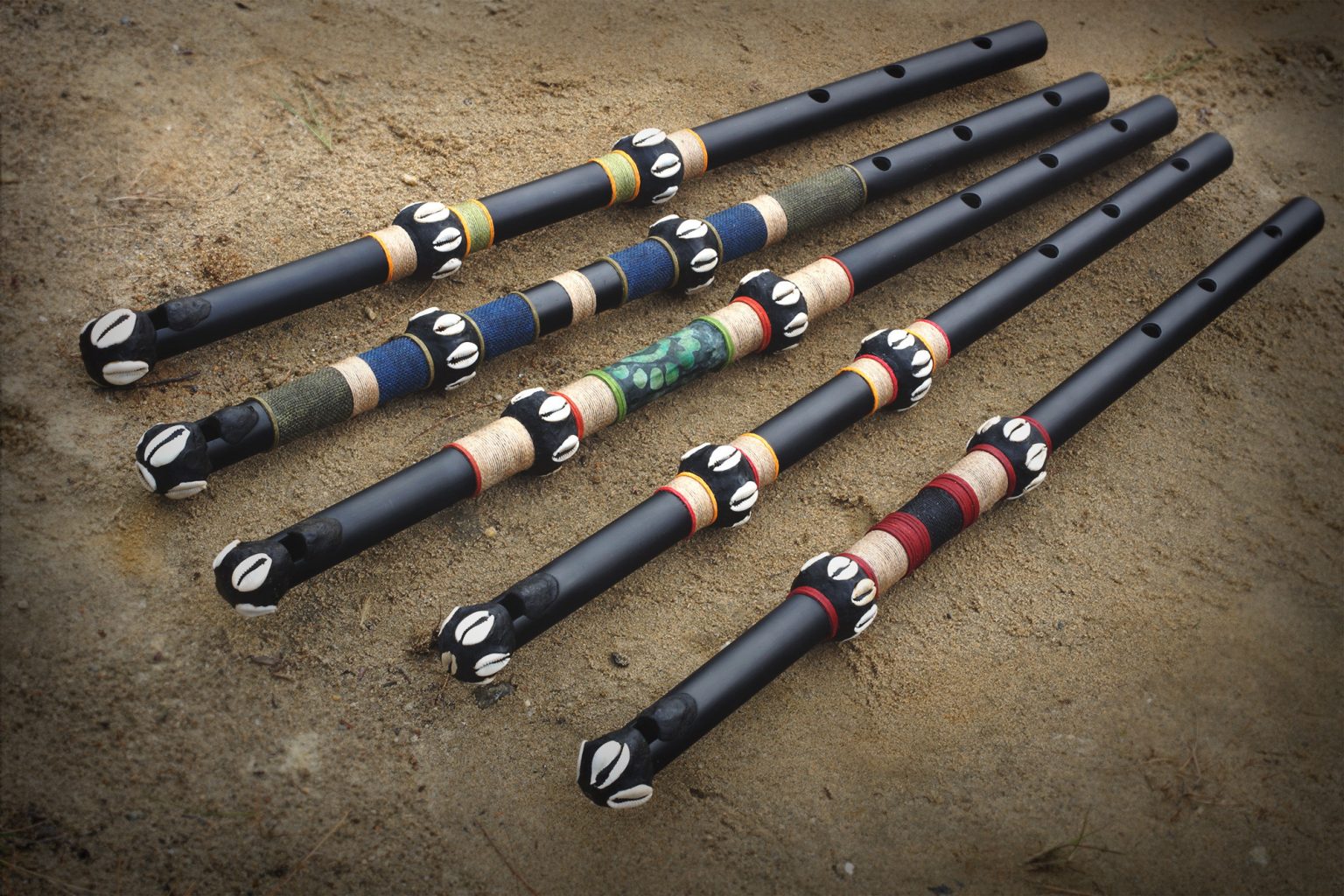Here are the most popular musical instruments in Africa. Outsiders have often overlooked the enormous variety of musical instruments in Africa in the mistaken belief that Africans play only drums. Yet even Hanno the Carthaginian, who recorded a brief visit to the west coast of Africa in the 5th century BCE during a naval expedition, noted wind instruments as well as percussion. Of an island within the gulf of “Hesperon Keras,” he wrote:
By day we saw nothing but woods, but by night we saw many fires burning, and heard the sound of flutes and cymbals, and the beating of drums, and an immense shouting. Fear, therefore, seized on us, and the soothsayers bid us quit the island. Ensembles fitting this description may be found over a wide area of West Africa today, serving as an accompaniment to dancing and merrymaking or as an essential ingredient of ceremonial or cultic activities.
Besides the percussion and wind instruments noted by Hanno, there are also stringed instruments of many kinds, ranging from the simple mouth bow to more complex varieties of zithers, harps, lutes, and lyres. While the aggregate of instrumental resources distributed over the continent is vast, each society tends to specialize in a limited assortment, and there is a wide variety from region to region. In some areas, interesting new hybrid varieties emerged in the 20th century in response to outside influence, notably the endingidi spike fiddle of Uganda, malipenga gourd kazoos of Tanzania and Malawi, and chordophones such as the ramkie and segankuru of South Africa.
Musical instruments in African societies serve a variety of roles. Some instruments may be confined to religious or cultic rituals or to social occasions. Among some people, there may also be restrictions as to the age, sex, or social status of the player. Among the Xhosa, for example, only girls play the imported jew’s harp, a modern replacement for the traditional mouth bow, which was formerly their prerogative.
Besides recreational applications, or as accompaniment for dancing, instruments may serve many other roles. In Lesotho, it is claimed that cattle graze more contentedly when entertained by the sound of the lesiba mouth bow. Among the Shona in Zimbabwe, a local form of lamellaphone known as likembe dza vadzimu serves in rituals of ancestor worship, while in the kingdom of Buganda the royal drums formerly held higher status than the king. In West and Central Africa, pressure drums may serve for the transmission of messages or, together with trumpets, for the declamation of praises, by mimicking the tonal and rhythmic patterns of speech. All sub-Saharan languages (except Swahili) are “tone languages,” in the sense that the meaning of words depends on the tone or pitch in which they are said. Consequently, instrumental music—or even natural sounds such as birdsong—often imitates or suggests meaningful phrases of the spoken language. Sometimes this is intentional and sometimes it is merely fortuitous, but in either case, it escapes the notice of uninformed outsiders.
Certain instruments are used solely for song accompaniment. Here the interplay between voice and instrument is often intricate and delicately balanced. Zulu solo songs, in earlier times, were often self-accompanied on the ugubhu gourd bow. In such bow songs, while the instrumental melody was influenced by the tone requirements of the song’s lyrics, the tuning of the bow determined the vocal scale to which the singer confirmed. Today when Zulus use the modern Western guitar, precisely the same antiphonal relationship and mutual interdependence between voice and instrument are maintained.
The following is a brief sampling of the principal instruments found in sub-Saharan Africa.
Idiophones

In this class the substance of the instrument itself, owing to its solidity and elasticity, yields sound without requiring strings or stretched membranes. Some are sounded by striking, others by shaking, scraping, plucking, or friction. Idiophones are numerous and widely distributed throughout the continent. On musical grounds, they may be divided into instruments used mainly for rhythm and several varieties tuned and used melodically.
Rhythmic idiophones
Among the vast array of nonmelodic, rhythmic idiophones, the most common and widespread are probably rattles, sounded by shaking. One type, the sistrum, which has small metal disks loosely suspended on rods, is important in the Coptic and Ethiopian churches (it is known in Ethiopia as tsenatsil) and is also used in Guinea. More widespread are hollow rattles, consisting of a gourd enveloped in a net of shells or beads or of a container such as a calabash with seeds or pebbles inside. Besides handheld varieties, there are many other kinds of rattles, often strung on cords, which may be attached to the limbs or other parts of the body and shaken while dancing or playing another instrument, or which may be fastened onto another instrument, such as the lamellaphone, to serve as a supplementary jingling device. In Zimbabwe, bottle tops, instead of the traditional snail shells, serve this purpose on the likembe dza vadzimu of the Shona.
Struck and concussion-sounded idiophones are found everywhere. These include stone clappers and multiple rock gongs (in Nigeria); wooden clappers and percussion beams; and implements such as hoe blades, weapons, and shields (in fact, all kinds of domestic items serve as temporary idiophones when required). Further examples are metal or wooden bells, either with internal pellets or clappers or externally struck; inverted half calabashes; bottles; and clay pots, partially water-filled, which in West Africa are struck with fanlike beaters. Stamping sticks are also used in West and Central Africa, as are stamping tubes made from bamboo or from long, open-ended gourds. In Ghana and Nigeria, the latter is used for accompanying certain women’s songs. Scraped and friction idiophones are quite widely distributed, the most common form being a notched stick or piece of bamboo that is scraped by another stick.
Slit drums
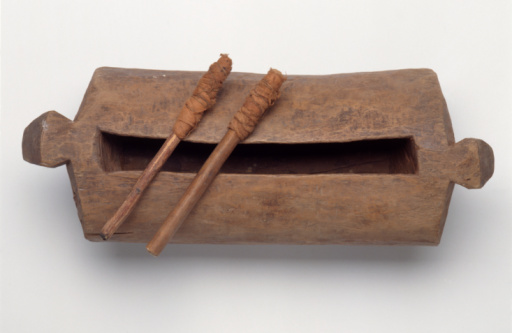
Falling between rhythmic and melodic instruments, the largest and most distinctive member of the African struck-idiophone family is the slit drum, made from a hollowed log. By careful thinning of the flanks at certain places, the instrument may be tuned so as to yield as many as four distinct pitches. Besides their use for transmitting messages, West and Central African slit drums are often played in combination with membrane drums and other instruments.
Xylophones
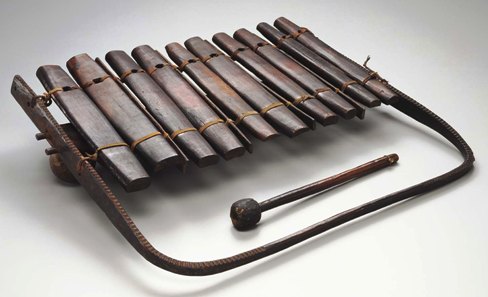
Two markedly different species of xylophone are distinguishable in Africa: one has free, unattached keys, and the other has fixed keys. With free-key xylophones, found in parts of West and East Africa, loose slabs may be laid across the player’s outstretched legs or supported on logs or straw bundles, sometimes above a resonating pit. In Uganda and Congo (Kinshasa), from two to six players may perform together on the same instrument.
Fixed-key xylophones are more elaborate. Mounted below each key, there is usually an individually tuned calabash resonator, often with a mirliton (a vibrating membrane) attached to add a buzzing quality to the sound. A mid-14th-century account mentions a calabash-resonated xylophone in the West African kingdom of Mali, and similar instruments were reported on the east coast in the 16th century. Xylophone ensembles are common in some areas, notably among the Chopi of Mozambique, where timbila orchestras of up to 40 xylophones, of six different sizes, have been reported.
Lamellaphones
These “thumb pianos” are plucked idiophones unique to Africa and widely distributed throughout the continent. In construction, they consist basically of a set of tuned metal or bamboo tongues of varying length fitted to a board, box, or calabash resonator, their free ends being twanged by the player’s thumbs and fingers. Supplementary rattling or buzzing devices are often added, and board-mounted varieties are often played inside a half calabash or bowl to enhance the resonance. They serve mainly for song accompaniment. Some common names for regional varieties of the instrument are likembe, mbira, and timbrh.
Membranophones
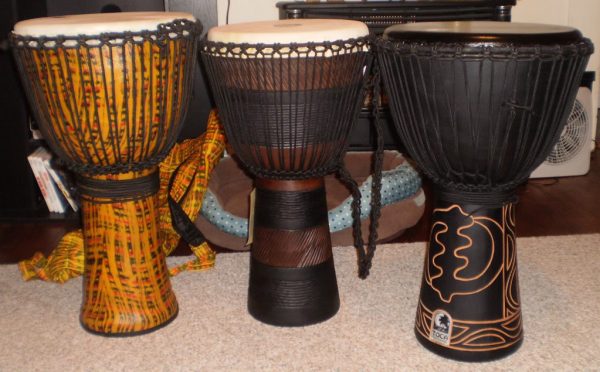
All African drums except the slit drum fall within this class, sharing the basic feature of having a stretched animal skin as their sounding medium. The mirliton, or small “singing membrane,” is often added to the bodies of drums and xylophone resonators as a supplementary buzzing device. It is an essential component of the malipenga gourd kazoos used in Tanzania and Malawi to simulate military band music.
Africa has a wide variety of drums, which may serve in a number of different roles, some of them not primarily musical. Their manufacture is often steeped in ritual and symbolism, and their use may be restricted to specific contexts. In many societies, only men may play them; in others, certain drums are used only by women (as among the Venda, Sotho, and Tswana of southern Africa). Playing techniques differ widely: some drums are beaten with bare hands, others with straight or curved sticks. Friction drums are also occasionally found, such as the ingungu used in Zulu girls’ nubility rites. Except in the extreme south, drums of contrasting pitch and timbre are frequently played in ensembles, with or without other instruments, to accompany dancing. Though the role of drums is usually rhythmic, the entenga drum chime in Uganda, comprising a set of tuned drums, plays vocally derived melodies.
The body of a drum may be either bowl-shaped, tubular, or shallow-framed. Bowl-shaped drums include those made from gourds and pots as well as the small and large kettledrums found in and around Uganda. Tubular and frame drums may have either one skin or two, which are either pegged, pinned, glued, or laced onto the body. Tubular drums come in many sizes and shapes, such as cylindrical, conical, barrel-shaped, goblet-shaped, footed, and hourglass-shaped. The atumpan talking drums of the Asante are barrel-shaped with a narrow, cylindrical, open foot at the base. East African hourglass drums are single-skinned. In West Africa double-skinned hourglass drums are held under one arm, their pitch rapidly and continually changing by as much as an octave by squeezing the lacing that joins the two heads. In some areas, the wax may be applied to the center of the drum skin, and a mirliton, shells, or jingles may be attached to the body to modify the tone.
Chordophones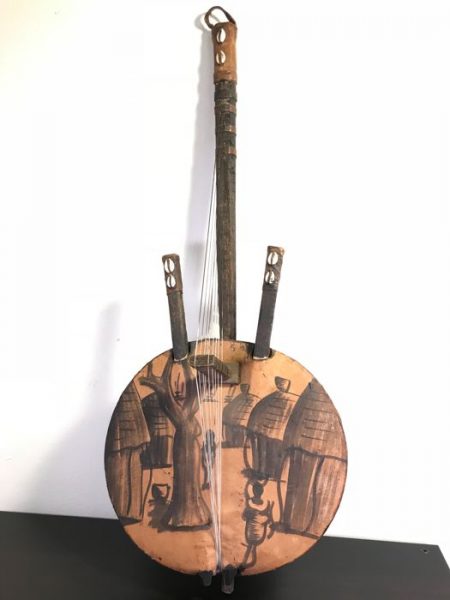 This class, comprising instruments that produce sound from strings stretched between fixed points, is well represented in Africa. There is an abundance of specimens in the form of zithers, lutes, and harps.
This class, comprising instruments that produce sound from strings stretched between fixed points, is well represented in Africa. There is an abundance of specimens in the form of zithers, lutes, and harps.
Musical bows
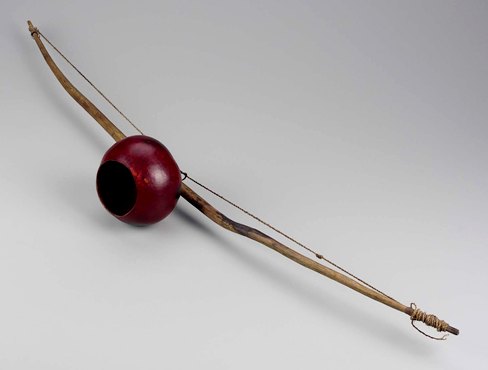
These consist of a string stretched between the two ends of a flexible stave. There are three types: bows with a separate resonator; bows with attached resonators; and mouth bows, which use the player’s mouth for resonance. Though it is conjectural whether all varieties evolved from the shooting bow, the San of the Kalahari often converts their hunting bows to musical use. Sometimes it is held against the mouth, yielding a range of mouth-resonated harmonics, as with the jew’s harp, or it is pressed against a hollow container. Apart from adapted shooting bows, more specialized types of musical bows are widespread. Most are sounded by plucking or striking the string, but the Xhosa umrubhe is bowed with a friction stick, the xizambi of the Tsonga has serrations along the stave that are scraped with a rattle stick, and the Sotho lesiba (like the gora of the Khoekhoe) is sounded by exhaling and inhaling across a piece of quill connecting the string to the stave. Bows with more than one string are rare, but the tingle apho of the Kara people in southern Ethiopia has three.
Besides mouth-resonated bows, the gourd bow, which has an attached gourd resonator, is commonly used in southern, central, and East Africa for self-accompanied solo singing. The string is struck with a thin stick or grass stem. The Zulu ugubhu is a typical example. Harmonic tones are selectively resonated by moving the mouth of the gourd closer to or farther from the player’s chest. The fundamental pitch of the string can be altered by finger stopping; with other types, like the Swazi makhweyane, a noose or brace divides the string so as to yield two different “open” notes, and resonated harmonics are selected in the same way.
While all the above types of the musical bow are simple forms of the zither, the so-called ground bow or earth bow of equatorial Africa, which has one end planted in the ground, qualifies as a ground harp.
Lutes
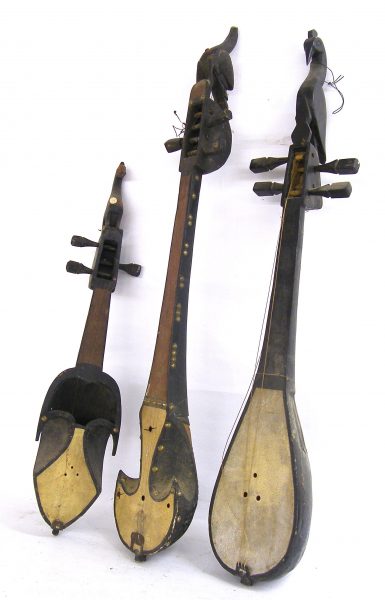
Characterized by strings that lie parallel to the neck, the lute is found in Africa in several varieties. The multiple-necked bow lute, or pluriarc, of central and southwestern Africa, is the oldest. This has a separate flexible neck for each string and resembles a set of musical bows fixed at one end to a sounding box. West African plucked lutes such as the konting, khalam, and the nkoni (which was noted by Ibn Baṭṭūṭah in 1353) may have originated in ancient Egypt. The khalam is claimed to be the ancestor of the banjo. Another long-necked lute is the ramkie of South Africa.
Fiddles
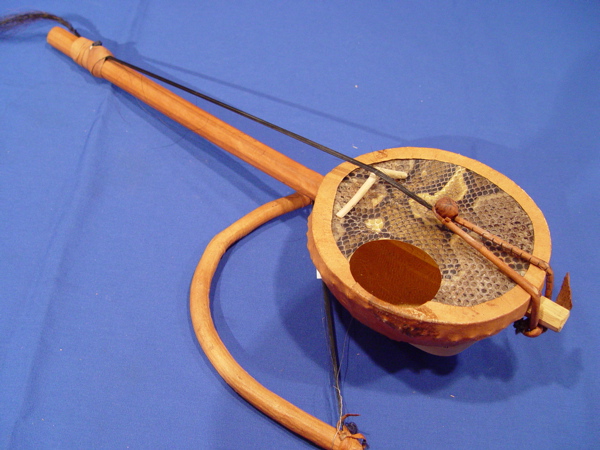
The bowed-lute family is represented by three types of one-string fiddle, as exemplified by the rebeclike goje of Nigeria and the spike fiddles masenqo of Ethiopia and Eritrea, and endingidi of Uganda—the last being a 20th-century invention.
Harp lutes
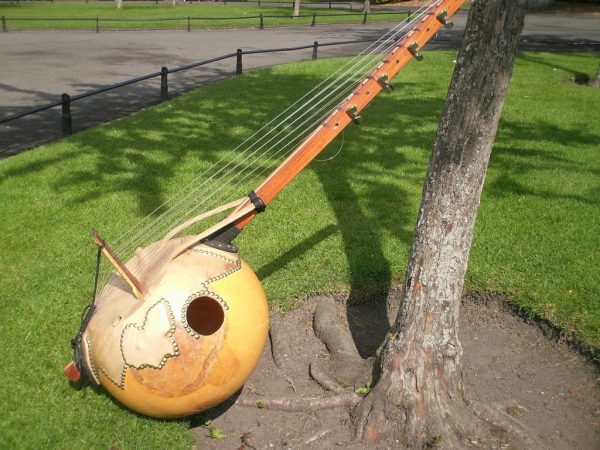
The sophisticated kora of the Malinke people of West Africa is classified as a harp-lute. Its strings lie in two parallel ranks, rising on either side of a vertical bridge, which has a notch for each string. The long neck passes through a large hemispherical gourd resonator covered with a leather-sounding table.
Lyres
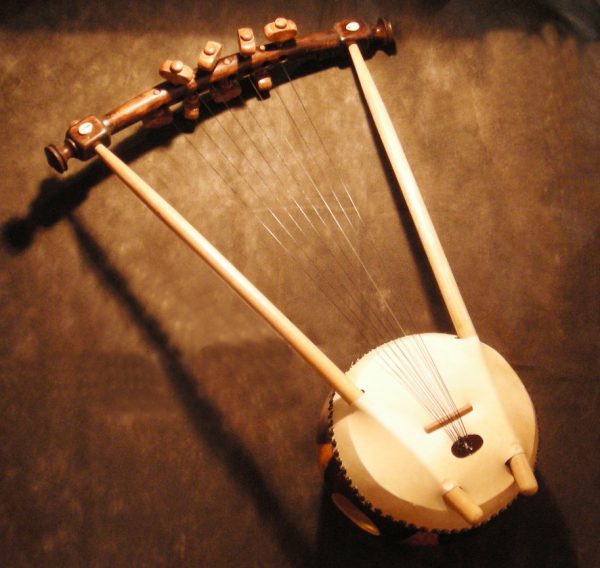
These have been termed yoke lutes, the strings running from a yoke supported by two sidearms. Their distribution in Africa is confined to the northeast. In Ethiopia and Eritrea two types occur the large beganna, with 8 to 10 strings and a box-shaped body (corresponding to the ancient Greek kithara); and the smaller six-string krar, with a bowl-shaped body (resembling the Greek lyra). The latter type, with four to eight strings varying in size, is also used in South Sudan, Uganda, and Kenya. The litungu is a typical specimen.
Harps

These are confined to a belt, north of the Equator, running from Uganda to Mauritania. All African harps (like those of ancient Egypt) are classed as open harps, as they have a neck and a resonator with a string holder but lack a supporting pillar to complete the triangle. In most cases, some form of buzzing device is incorporated. Examples are the ennanga (Uganda), ardin (Mauritania), kinde (Lake Chad region), and ngombi (Gabon).
Aerophones
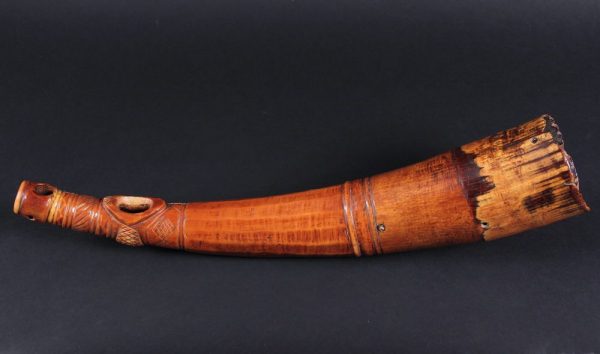
The archaic bull roarer (a board attached by rope to a stick and whirled about in the air) survives in various localities, notably in southern Africa among the San and neighboring peoples. Of the wind instruments proper, the three main divisions—flutes, reed pipes, and trumpets—are all well represented, though the second of these is more restricted in distribution than the others.
Flutes
At the southernmost tip of the continent, the navigator Vasco da Gama in 1497 encountered a band of Khoekhoe people “playing upon four or five flutes of reed.” Ensembles of single-note stopped flutes playing on the hocket principle, with each flute blowing its note in rotation, have been reported from various regions, ranging from southern Africa through eastern Congo (Kinshasa), Uganda, and South Sudan to southern Ethiopia. Panpipe ensembles are less common, but notable examples have been witnessed in central Africa, particularly among the Nyungwe of Mozambique. There are many other types of open and stopped flutes—cylindrical and conical; transverse and end-blown; made from bamboo, reed, roots, stems, wood, clay, bone, and horn. Globular flutes made from small spherical gourds or from hard-shelled fruits such as Oncoba spinosa are found in southern Africa, Congo, Mozambique, Uganda, Guinea, and elsewhere. End-blown notched flutes, with a U- or V-shaped embouchure, either with or without finger holes, are widely distributed across the continent. The long Zulu umtshingo has an obliquely cut embouchure; there are no finger holes, but a double range of overblown harmonics is produced by alternately stopping and unstopping the lower end with a finger. Such instruments and many others throughout the continent are played singly, but in many areas flutes are played in pairs or in combination with other instruments.
Some of the percussion instruments of the Western orchestra (clockwise, from top): xylophone, gong, bass drum, snare drum, and timpani.
Trumpets

Lip-vibrated aerophones made from a variety of materials are widespread in Africa. Apart from musical uses, some serve for signaling. In West Africa, side-blown ivory or horn instruments may transmit verbal praises of chiefs and rulers. Among the Hausa, the long metal kakaki and wooden farai, both end-blown, fulfill this role in combination with drums. In East and Central Africa, the instruments are often made from gourds, wood, hide, horn, or a combination of these materials. In the historic kingdom of Buganda (now part of Uganda), trumpet sets were part of the royal regalia. Throughout Africa, more than one or two notes are seldom produced from a single trumpet, but trumpet ensembles are common, playing in hocket fashion.

